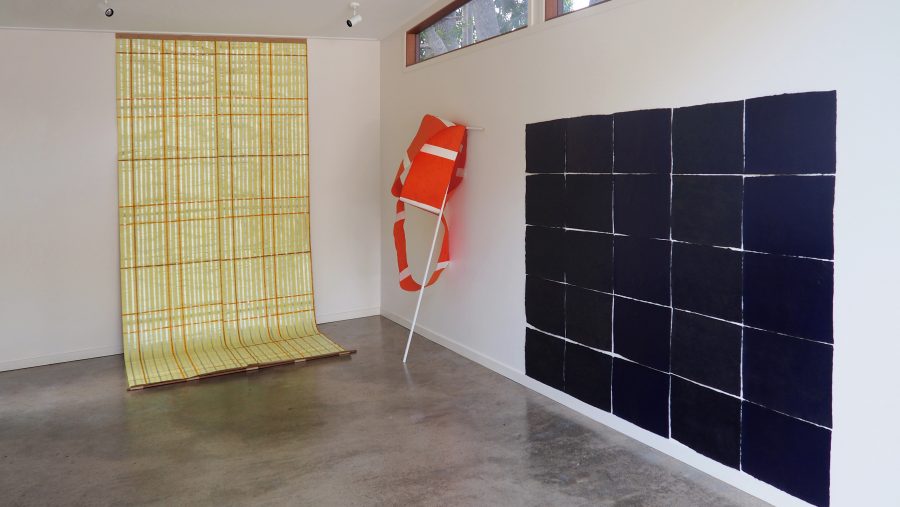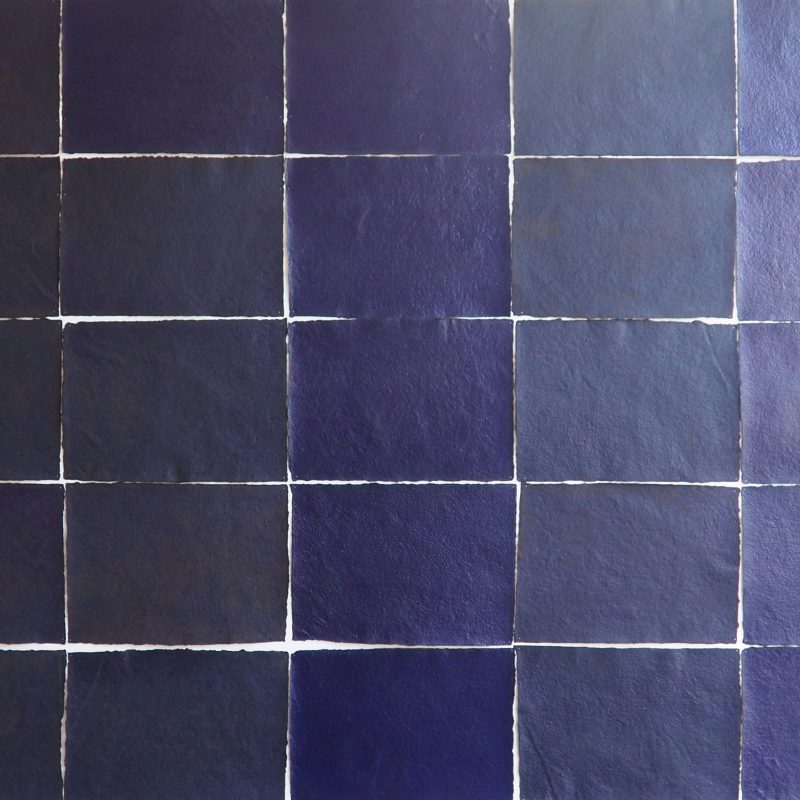In Michael's studio, looking over finished works and works-in-progress in preparation for this exhibition.
MICHAEL: Are you going to come to the bump-in?
BETH: Yes I will be there Monday morning – how long do you think it will take?
I’m not sure … well I have always liked that story of Alexander Calder when he had an early solo show — (maybe in New York). So he arrives at the gallery with a suitcase, coils of wire and a pair of pliers.
Oh no way!
Then he sits down, looks around, and made the work.
Yes I can understand that. Because you put a frame around yourself don’t you? You say to yourself — I’ve got these materials in this window of time and I’m going to complete something. There’s a great meditation in that isn’t there?
Yes. So with the Tarkine piece — there’s 24 or 25 panels — so I’ll put that in the space and see how it goes — how it looks, how it feels. And then this piece hangs. So I take stuff to a space and then the story evolves in that interplay. I think that’s really important.
So it will be great for me to be there. Will you be trying to balance the works? Are the works very different or is the exhibition one thing in your mind?
Mmmm … you see I’m never sure. Sometimes I would like to think so but …
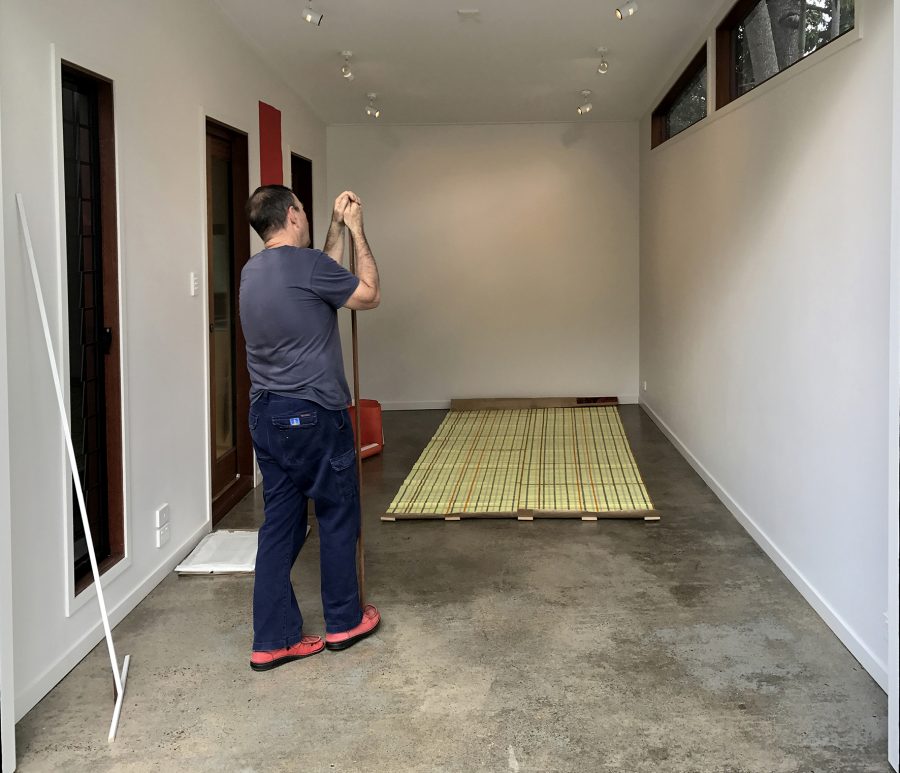
So you’ve made one of these loops. How many loops will there be?
There’ll be three. And that’s probably a scale thing too because I’ve been looking at the space and where it might go.
Yes so you have the floor plan and you’ve imagined it.
Yes and I’ve seen other shows there and it’s one of those spaces — or I suppose it’s any space really — I just don’t like seeing things that are just stuck on the wall.
Yes, it’s lazy.
It is. Sure for a body of work I can see that, but then I just think with all works there is a series of engagements. Spaces are important in terms of engaging works, especially when you look at the European tradition — my god, you can hang a grand piano upside down in the most beautiful cathedral space in Germany and they say ‘yeah go for it! And do you want an orchestra to go with it because there are a few in town and they’re looking for a gig that night!’ It’s another ball game and it’s truly fantastic.
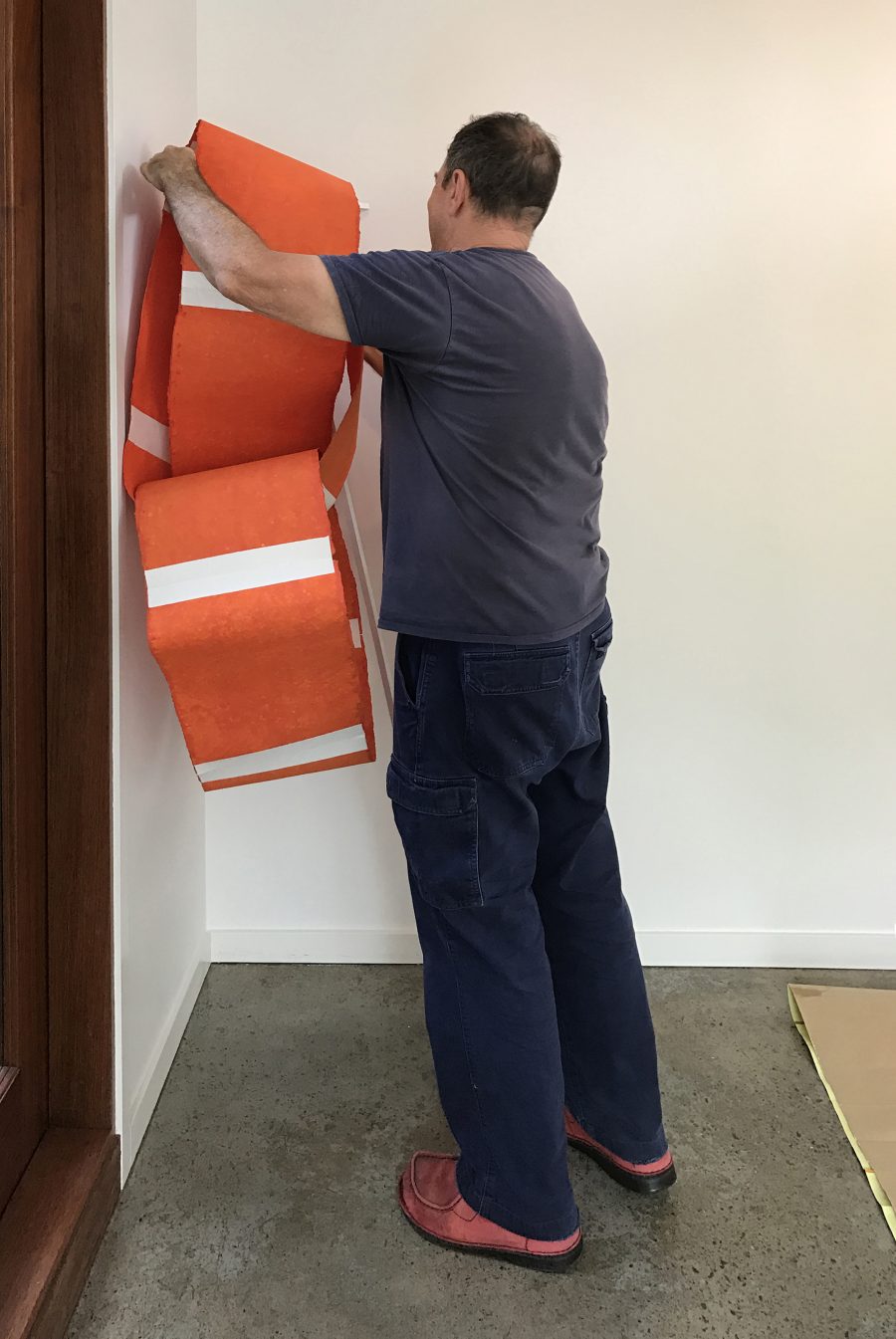
I find these works very careful — in the simplicity of your approach and your concern for materiality. You have used paper so consciously as this organic matter. And then you have used colour as a substance in and of itself.
Oh well colour is the unsung story in our world. We just treat colour as colour — but colour is magic! Colour is about light coming from a star that died millions or trillions of years ago, bouncing of something and coming back into our eyes and making a code. I mean that’s just so out there it’s extraordinary. And yet we just go ‘oh I don’t like yellow!’
So you think that colour is a foundational connection between us and the world around us? The perceptive phenomena in which we exist?
It’s like what you were saying earlier about the emotional nature of food — colour is like that, like what we eat. It’s what we dress in, what we cover ourselves in. It’s a huge driving force.
And the way Nature uses colour — like flowers in the forest and the garden, colour is just so important. And it’s incredible isn’t it, when you get these beautiful flushes, and then birds themselves as flashes of colour through a forest — the way they signal to each other.
Yes it’s defence, attraction, all that sort of stuff. It’s really extraordinary and so beautiful.
It’s probably the basis of beauty isn’t it?
Without getting into the debate about what constitutes beauty, then yes. In terms of how those things function in the natural global environment, that’s the real thing — that’s where it’s all at.
So in this space you’re creating, the colour is really a conductor? You’re transporting people into that zone or your providing colour as a vehicle or means for their own transport?
Yes it’s a code, part of a code, absolutely — my visual code. And that’s a colour palette that I’ve been interplaying with for many many years.
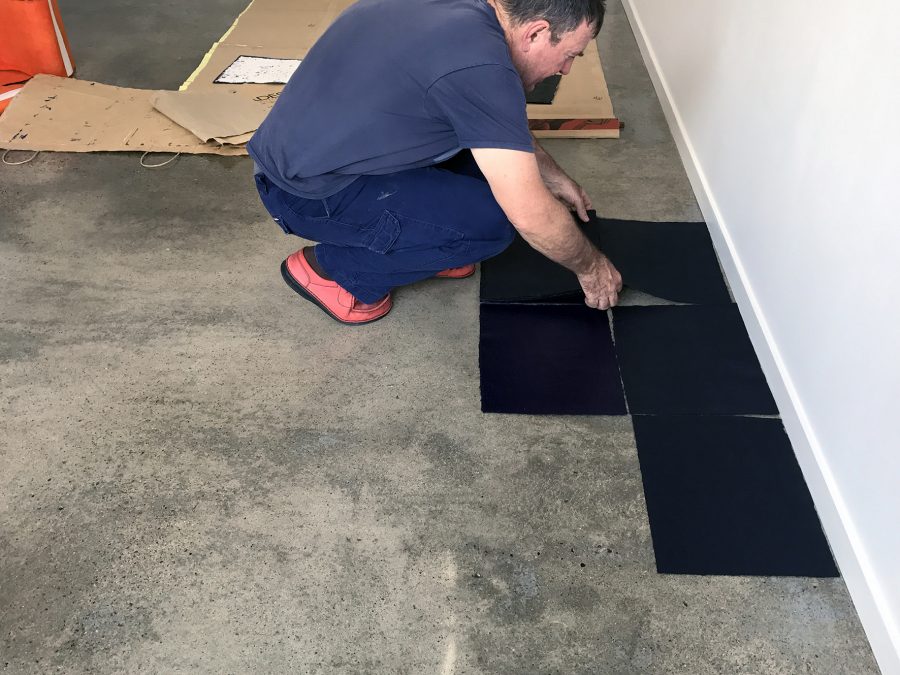
So the black sheets called The Tarkine …
They’re blue actually.
They’re blue?
Mmmm
Oh wow so I didn’t even see that.
Yes so well I started off with the first layer of those as a wetted sheet with the ink, then brushed onto the wetted sheet, and that was a yellow ink. And then a wetted sheet again and then a brown ink painted on. And then sheets dried and then three blues. One group has got three blues and then the others have two blues. So that was the first batch with the three blues and those are the two blues … so there’s no blacks in them.
That’s amazing.
So this work is about fossilisation and sedimentation and that push through the land of a really wild energy.
So this is about the fossil fuel, what the forest turns into over millennia?
Yes and we’re part of it.
That carboniferous life chain.
Yes — so that’s that piece. This other one will be all joined into one length. It’ll be on one of those side walls I think.
How are you hingeing them?
Just with book-binders paper.
So it’s a book, an artist’s book perhaps. It is the paper and the forest and the book and language, both human and nature as a chain of meaning through intelligent life cycles — is that it?
It’s on that path yes. Because that’s how I think we need to live on this planet now … because if we don’t get that we’re fucked. I mean, we’re pretty fucked now!
I know. It’s not good news is it. So how many will be joined in ‘the book’.
There’ll be five. So that also becomes a sculptural element too so that the piece would be more to do with the geological eras — the build-up of sedimentation as strata etc. So the coal deposits that are going to expire in 150 years have taken millions of years to make. It’s that disregard for the time scales we have now that I find extraordinary.
Well in fact the way we’re impacting the planet now actually goes beyond those geological cycles — such as the way we’re extracting and transporting things like phosphorous around the planet.
And we have no idea what that does or the potential effects.
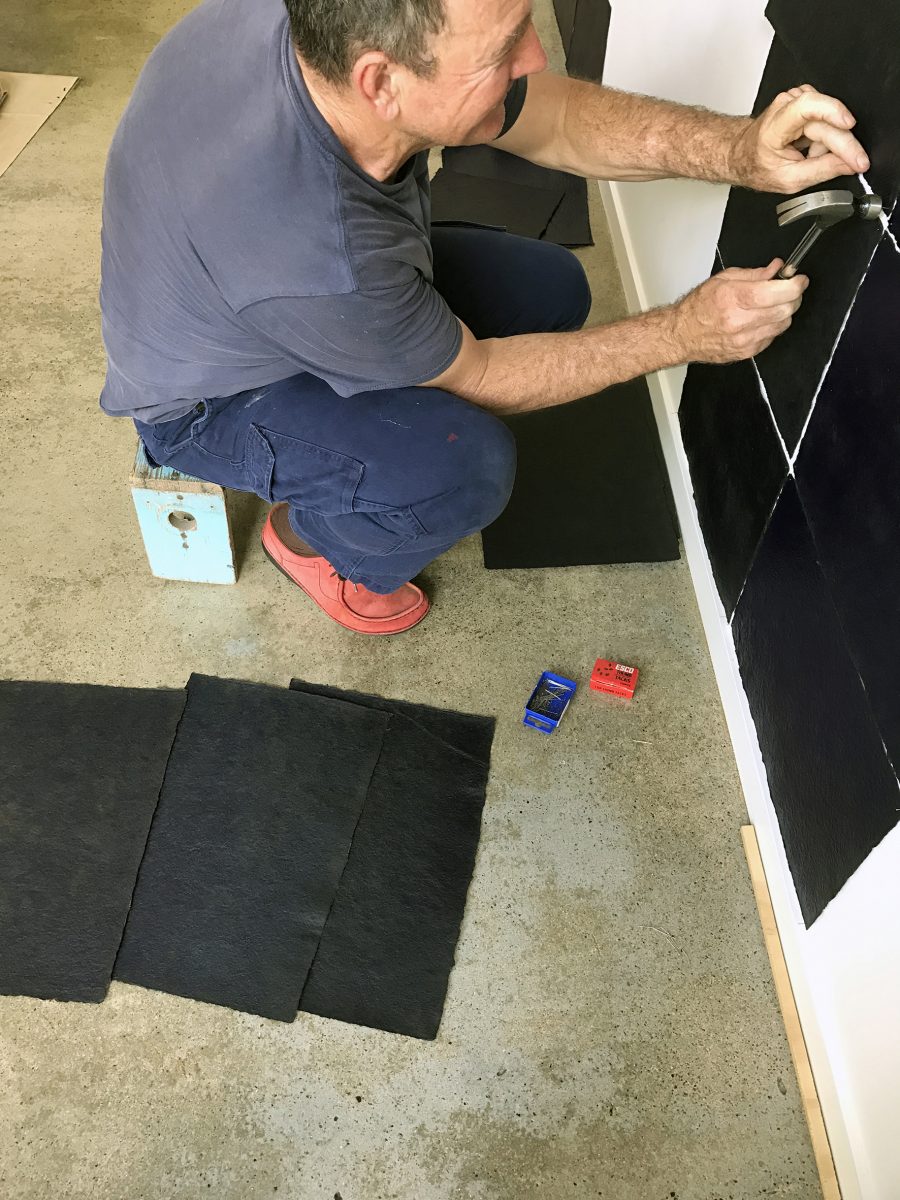
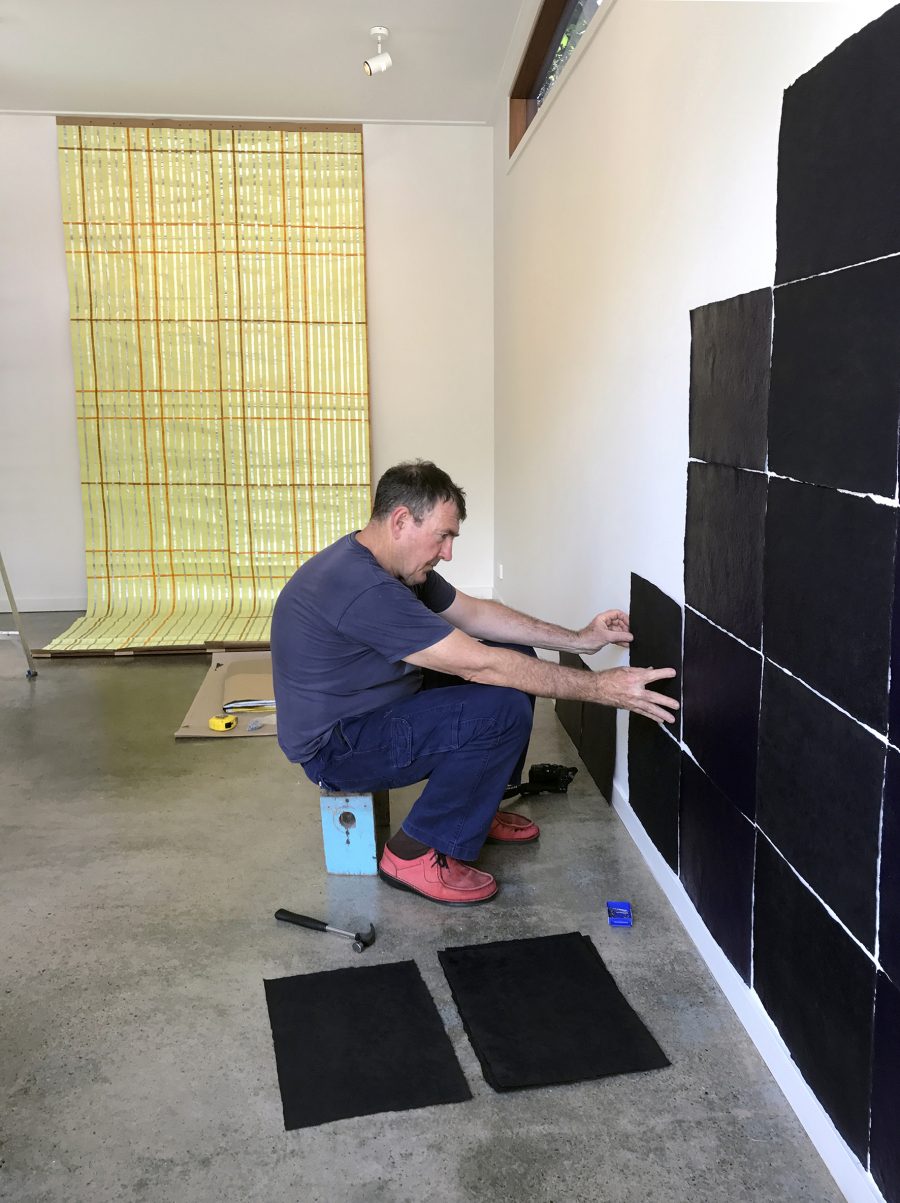
So in some ways your work is a slowing down, inviting people to meditate or reflect more? To de-celerate? To stop consuming?
Oh absolutely. To do nothing in fact. And it’s ok to do nothing. Because you can do a lot of things when you’re doing nothing. You know? It’s not hard. It’s very constructive. And I think we’re just not taught those lessons from an early age — it’s all about doing!
Yes and accomplishing more and being ambitious …
Which in the short term is understandable — parents are concerned about their children’s future blah blah. I get it but it’s the wrong book now. We need something else because that system is completely unsustainable. Nearly everyone can see that. We know it. We just need to act on it. And that’s where Naomi Klein in her book ‘This Changes Everything’ is fantastic because she is a very astute scholarly, diligent person and she writes this great introduction where she says ‘well I’m an educated western woman, I know about these things and so on’ but the big thing that was really troubling her was well ‘I’m still ignoring this. I’m still carrying on the same way as I did before. I need to actually focus on this problem and see what constitutes it.’ So when you can see that through someone with her eye and brain and her way of actually fleshing things out that’s a good insight. You may not agree with everything of course but it’s a good overview. And there’s a lot of people out there in the arts industry / arts area that have been focused on this sort of reference to their works for many many years.
Absolutely. So that’s where it’s lovely to make that connection with the Fluxus artists from that earlier period and Alison Knowles and your experience with her when she came to Brisbane many years back and references you’ve made to her in your other artworks. Fluxus was about the democratisation of art, its reproducibility and where art itself can be a tool for everyday life — we were all invited to participate in a creative acts — where making a salad together was art or could be.
Yes with references back to community and participation at various levels.
And finding that road between high brow notions of art for an elite and low brow versions of art in popular culture. Alison Knowles treads an alternative path to any of that structure really.
She just cut her own road.
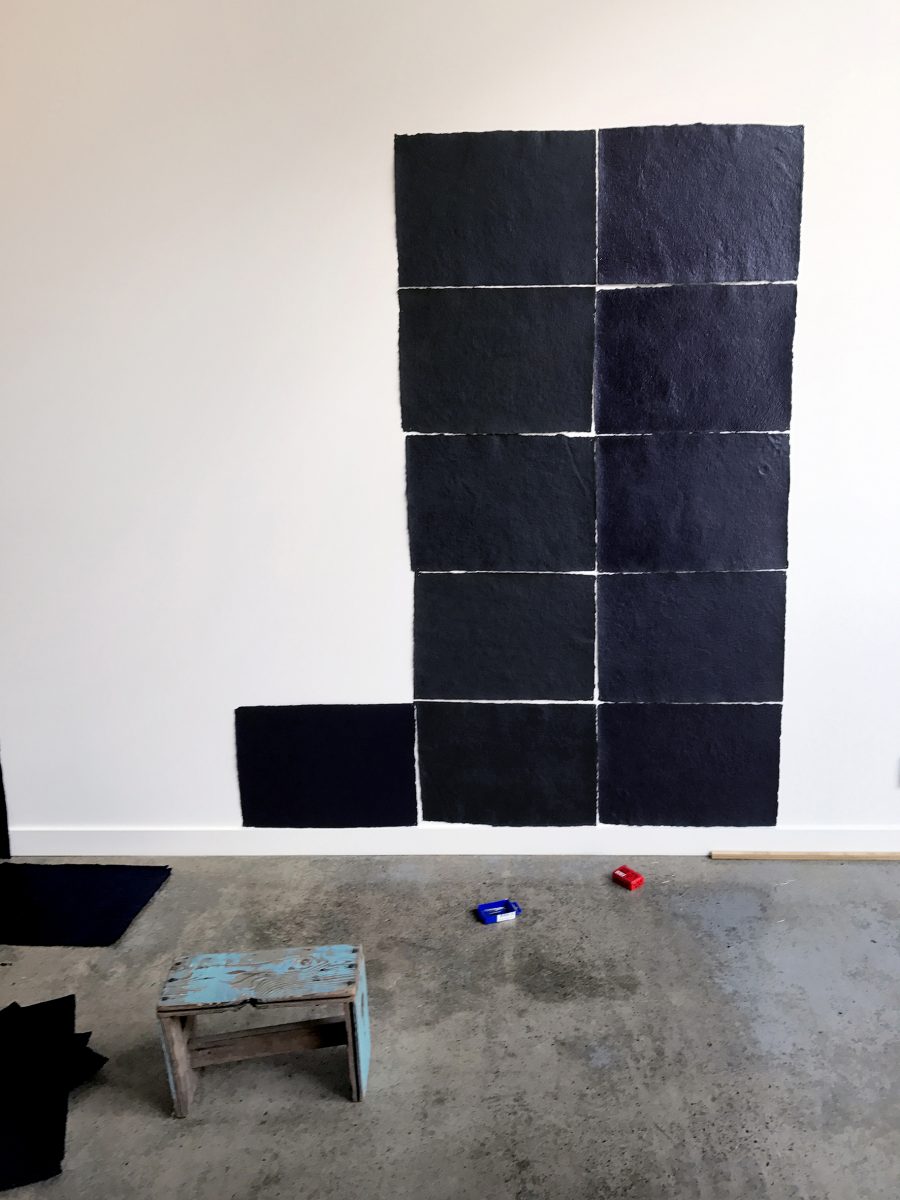
It is beautiful to see the carefulness of your work and how there is an ethics involved in how you approach your work and the materials, the choices that you’re making. You know that modernist maxim ‘truth to materials’ or ‘form follows function’ that was all about an industrial era of brutal material ‘honesty’ of high modernism, there’s a ‘truth to materials’ going on here that is not industrial which is hand-made, almost pre-industrial.
Well that’s certainly why I chose this particular paper because of the handmade quality. But also because, being from India, no two sheets are the same, where if you were buying beautiful French watercolur paper or something like that, there might be some variation in the decal but nothing like this! So that gives it a really beautiful quality too I think.
And a subtlety with your own process — your materials are answering you back in unexpected ways.
Exactly! The way the ink actually falls and is absorbed is quite different. And I like that whole variation — it just happens.
And it will change with the time of day — Side Gallery has that beautiful clerestory.
Yes you do get that. There is a degree of transparency and that’s because of using ink — it’s more like a dyed effect rather than a painted effect.
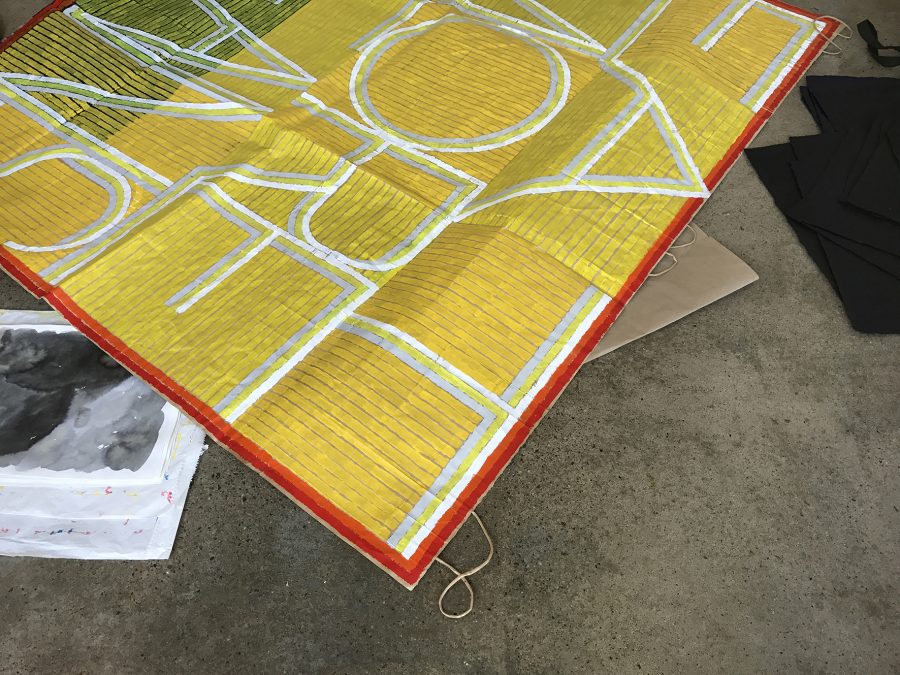
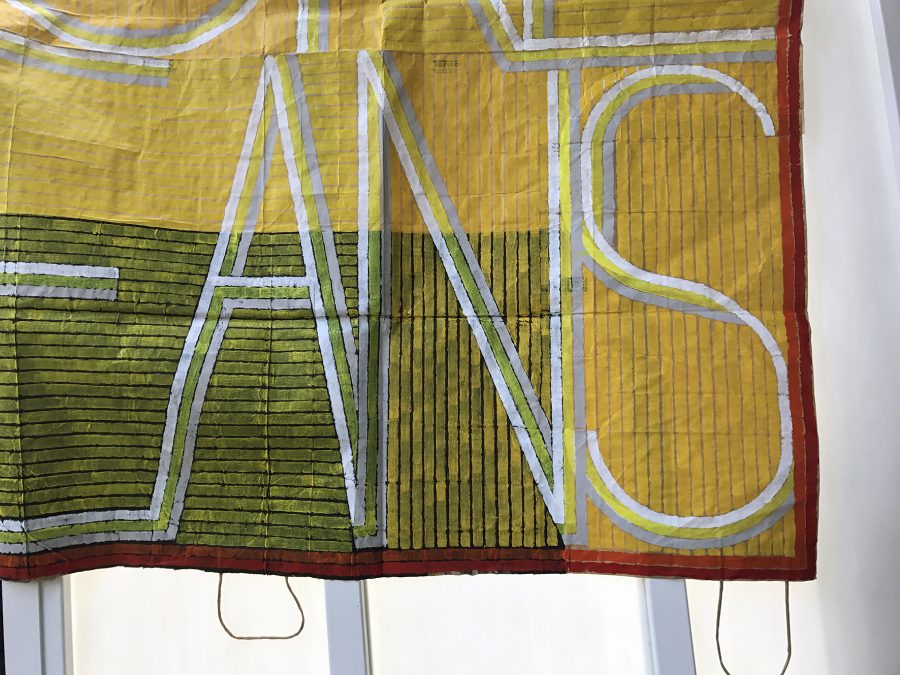
And is there any text in this show? Any words?
No, just the titles of the pieces. There’ll be this built piece. There’ll be that built piece. That I will take along and they may or may not make it into the actual exhibition. And then there is another piece that I would like to show. But again it just depends how it actually works. So this piece is made out of shopping bags.
So you’ve used a backing? Or that’s the whole bag?
Yes that’s just the bag. So I’ve dissected the bags and then joined them together and then painted. So this is painted, not inked. So it’s like a wall paper.
And you can see all the brush work.
Yes it’s quite raw. Because I wanted that human presence.
Did you draw it first — grid it up? Or is it all freehand?
All freehand. I’ve just followed the existing folds and creases, so that informed the geometry of it. Because I can’t sit down and think about that — I just let the thing drive. I just start and it drives itself in the end — the bag geometry.
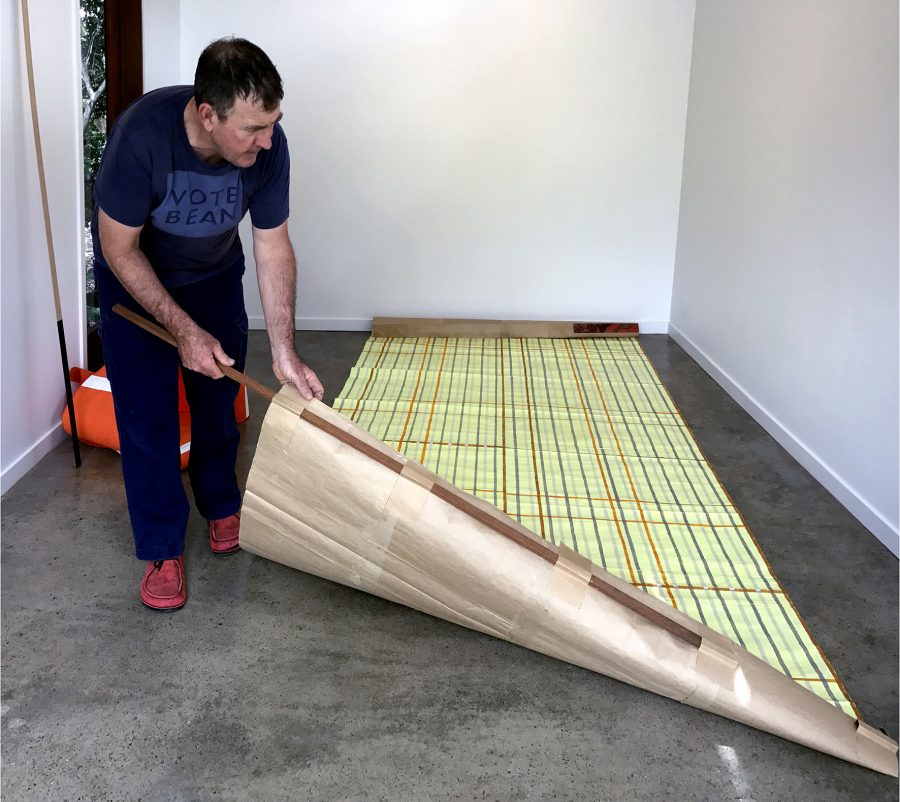
And is the grid important to you? As a compositional device of modernism? As a student of architecture?
Yes. As a reference to architectural spaces, to the way we grid things up to see things, classifying things. Yes it’s a general overlay device. And can be really beautiful too.
So that formalism frames things and makes them special. Creates the meditation perhaps?
Yes it does give you a meditative screen. The work is related to when people leave their spaces or their homes, all their actual presence disappears with that too so it becomes a vanished room, a vanished space.
That’s a vanished room?
Mmm. This was related to a friends’ parents, Shirley and Colless Lahz, who had this really beautiful place in Newtown. Both Shirley and Colless had collected some beautiful books and artworks. Shirley was this dynamic four foot person — intense, obsessive and would drive her daughter insane with her requests — anyway she was fantastic and she died this year. Well they had to go into a Care Facility. And theirs isn’t an out of the ordinary example, but all of a sudden everything changed because they had to sell the house. So this collective life and this beautiful thing that was happening and this really beautiful space is gone. And I think we don’t give that due respect. We’re so quick to move on to the next thing — I’ve got to renovate this room and so on.
We don’t allow our habitable spaces to evolve.
For a whole range of reasons — theirs were very practical reasons because they needed the money to keep their parents in care which is perfectly reasonable but it is also brutal. And it’s an example of what is critically wrong with our society now — the outside forces that drive that, making people have to do that, creates these emotional gaps in people’s lives.
The churn.
All this emotional churn — onto the next thing, onto the next thing.
It always reminds me of the original dispossession of Aboriginal people in this country. So we’re just continually doing that. To all of ourselves. We buy and sell land and people are allowed to have it for certain purposes. But it’s so short term and no one can keep up with it, so there is a continual land-grabbing going on and an erasure going on. We’re locked into it in a profiteering mentality. And Australia is disappearing before our eyes. And, as you say, it becomes impossible to live inter-generationally in one place.
Or die. In terms of my father’s generation or his father’s, they had unwed aunts in Ipswich that stayed on in one place. But of course when they died it all goes. And they had the most beautiful garden — and as a reflective work, gardens are so important, but they are given scant regard. Or any space that exists to give openness to built forms is seen as space that you can build on. So by taking away that outside space, everything becomes more and more internalised because there is no outside space. So that is referenced by the grid too, but it’s also breaking that grid down a bit. So that’s where that work came from.
So were the paper bags used to move things?
They’re just ones that I collect. There is that other side too.
Recycling things? Finding the everyday precious?
Paper bags are really beautiful. As a simple way of doing things they have a beautiful feel about them and they can be reused or just put into the compost.
So this will go into the Gallery if you can find a place.
Because I thought it could be quite nice sweeping through the air … but I’m not sure … or I do like the potential of it just being rolled up like that and put in the corner.
Oh that’s a bit cruel!
Cruel is good.
Well that seems like a good note to finish on.
Yes so we will see!
